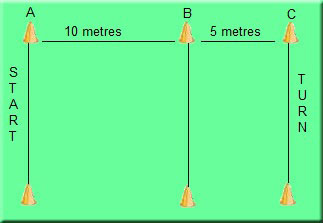

505 Agility Test
Testing and measurement are the means of collecting information upon which subsequent performance evaluations and decisions are made. In the analysis, we need to consider the factors influencing the results.
Objective
The 505 Agility Test (Draper 1985)[1] objective is to monitor the development of the athlete's speed and agility.
Required Resources
To conduct this test, you will require:
- Six cones.
- Flat non-slip surface.
- Tape measure.
- Stopwatch.
- Assistant.
How to conduct the test
This test requires the athlete to run from the “Start” line to the “Turn” line and return to the “Start” line as fast as possible (see the diagram below). The athlete must step past the "Turn" line with both feet before returning.
- The athlete warms up for 10 minutes.
- The assistant sets up the course as detailed in the diagram.
- The assistant gives the command "GO".
- The athlete commences the test running from Line A to Line C and back as fast as possible.
- The assistant starts the stopwatch as the athlete passes line B on their way to the "Turn" line (the athlete must step past the "Turn" line with both feet before returning).
- The assistant stops the stopwatch when the athlete passes line B on their return to the "Start" line and records the time.

Analysis
Analysis of the test result is done by comparing it with the athlete's previous results for this test. It is expected that, with appropriate training between each test, the analysis would indicate an improvement in the athlete's agility and speed.
Target Group
This test is suitable for active individuals but not for those where the test would be contraindicated. This is an appropriate test for game players (e.g. football, rugby, hockey, basketball, squash, tennis, badminton) as the shuttle format makes it sport-specific.
Reliability
Test reliability refers to how a test is consistent and stable in measuring what it is intended to measure. Reliability will depend upon how strictly the test is conducted and the individual's level of motivation to perform the test. The following link provides a variety of factors influencing the results and test reliability.
Validity
Test validity refers to the degree to which the test measures what it claims to measure and the extent to which inferences, conclusions, and decisions based on test scores are appropriate and meaningful. This test provides a means to monitor the effect of training on the athlete's physical development.
Advantages
- Minimal equipment is required.
- Simple to set up and conduct.
Disadvantages
- Specific facilities required - non-l. slip surface.
- An assistant required to administer the test.
References
- DRAPER J.A. and LANCASTER M.G. (1985) The 505 test: a test for agility in the horizontal plane. Aust J Sci Med Sport, 17 (1) p. 8-15
Page Reference
If you quote information from this page in your work, then the reference for this page is:
- MACKENZIE, B. (2005) 505 Agility Test [WWW] Available from: https://www.brianmac.co.uk/agility505.htm [Accessed